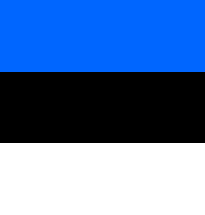 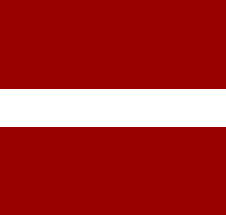 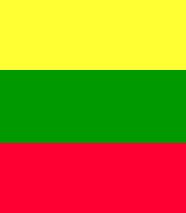 |
Estonia | Part 3 |
| Latvia | ||
| Lithuania |
Friday 12 September 2014
Liepaja - Nida: 151km, 94 mi; 3 hrs
After breakfast 001.jpg) we
go and have coffee at Darbnica. It now starts raining heavily. We have to
run back to the hotel in order to avoid getting too wet. After we check out
I discover to my horror that my debit card is missing from my wallet.
Nowhere to be found. Yesterday I withdrew money at an ATM nearby. We decide
to go back there to check. The front desk attendant is a bit reticent at
first, but then asks a few questions and asks for my ID. After some thought
and discussion she says she normally does not give back found cards, and
then she picks my debit card from a drawer. She says she heard the ATM
squeak yesterday . I'm happy having my card back. My excuse is that in the
Netherlands you take the bank card from the machine before you can get your
money. Here your debit card comes out of the machine only after you have
received your money and receipt. We better watch out then!
we
go and have coffee at Darbnica. It now starts raining heavily. We have to
run back to the hotel in order to avoid getting too wet. After we check out
I discover to my horror that my debit card is missing from my wallet.
Nowhere to be found. Yesterday I withdrew money at an ATM nearby. We decide
to go back there to check. The front desk attendant is a bit reticent at
first, but then asks a few questions and asks for my ID. After some thought
and discussion she says she normally does not give back found cards, and
then she picks my debit card from a drawer. She says she heard the ATM
squeak yesterday . I'm happy having my card back. My excuse is that in the
Netherlands you take the bank card from the machine before you can get your
money. Here your debit card comes out of the machine only after you have
received your money and receipt. We better watch out then!
We drive through the rain to Klaipeda in Lithuania. We visit the Akropolis
shopping mall in a suburb. Here we find a branch of Omnitel, where I want to
buy a new sim card for the internet in Lithuania. The sim card is quickly
arranged and is activated by the ladies in the store with their own phone.
For 3 GB I pay about 5 euros. For the first time on this trip we have to pay
with a different currency, the Litas. Until December 31, 2014 Litas is still
the Lithuanian currency (1st Lt = 0.29). One day later Lithuani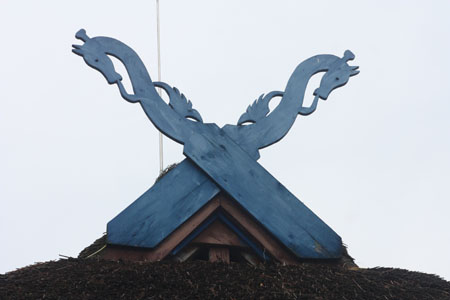 a
will join the Euro zone.
a
will join the Euro zone.
We drive on and within minutes we are at the ferry port for the ferry to the
Curonian Spit. This is a peninsula of 98 km in length that separates the
Baltic Sea from the Curonian Lagoon, a kind of lagoon. Within ten minutes we
sail out for a crossing of 5 minutes. On the other side we drive for 50km on
the Spit to Nida. The Spit is 3 km wide at the most and in many places even
narrower. In Nida we find our accommodation in
B&B Naglis. We
have a very spacious room on the first floor overlooking the lagoon. This is
a coast where a narrow isthmus shields a large lagoon from the sea. It is a
freshwater lagoon. The Curonian lagoon and the Spit are shared by Lithuania
(north) and Russia (south). That is, the Russian enclave of Kaliningrad,
part of the former East Prussia with its capital Königsberg, which was after
the Second World War incorporated into the Soviet Union and renamed
Kaliningrad, named after Mikhail Kalinin, co-founder of the communist party
newspaper Pravda. After the disintegration of the Soviet Union, the area
became part of the Russian Federation. Nida is located a few kilometers from
the border. The Spit is attached to the mainland on the Russian side.
We move into our spacious room and then go and have lunch in Ešerinė, down
the street. Later we buy stamps at the post office, post cards at the
tourist info and take the car and drive to the former summer residence of
the German writer Thomas Mann (1875-1955). The great
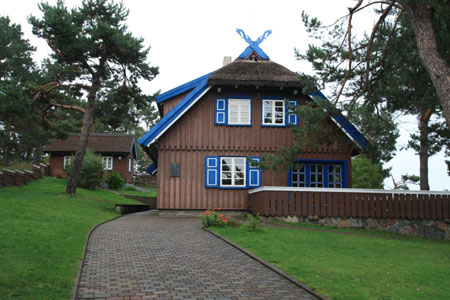 writer
and Nobel Prize winner spent his summers of 1930 through 1932 here. He had a
summer house built here by an architect from Klaipėda (then the German city
of Memel). Mann described the residents as "not really handsome, but
friendly". He wrote "Die Geschichte Jaakobs" and "Der junge Joseph", who
were part of his tetralogy "Joseph und seine Brüder". The museum is not very
special. Some photos of Mann and his family in Nida (then called Nidden) and
a silhouette of his desk in his office made from wire and there is a replica
of the chair that once stood here. However, more fun is a film that is
shown, in which we listen to a talk that Mann held in 1931 for the Munich
Rotary club about his summers in Nida. The text is read and historical and
new images are shown to illustrate it.
writer
and Nobel Prize winner spent his summers of 1930 through 1932 here. He had a
summer house built here by an architect from Klaipėda (then the German city
of Memel). Mann described the residents as "not really handsome, but
friendly". He wrote "Die Geschichte Jaakobs" and "Der junge Joseph", who
were part of his tetralogy "Joseph und seine Brüder". The museum is not very
special. Some photos of Mann and his family in Nida (then called Nidden) and
a silhouette of his desk in his office made from wire and there is a replica
of the chair that once stood here. However, more fun is a film that is
shown, in which we listen to a talk that Mann held in 1931 for the Munich
Rotary club about his summers in Nida. The text is read and historical and
new images are shown to illustrate it.
After the Mann house we go and eat at
Seklyčia
on the waterfront. This is supposed to be finest restaurant in Nida. The
food is great and the ambiance too, although they are missing a few details
in running the place.
Weather: rain and 16°C/61°F. After 5pm it is
dry
Saturday 13 September 2014
It has rained most of the night and this morning it is still wet outside.
We eat breakfast
001.jpg) in
the small dining room. We are the only ones there. The other guests
apparently not eat that early in the morning. Everything is ready and the
owner makes us an omelet with cheese.
in
the small dining room. We are the only ones there. The other guests
apparently not eat that early in the morning. Everything is ready and the
owner makes us an omelet with cheese.
After breakfast we go and drink some coffee, at least that's the plan. But
before 9am nothing happens here. We therefore take the car to the viewpoint
in the dunes. The dunes of the Curonian spit are a highlight of a stay in
Nida. More than 50 meters high, they overlook both the Baltic and the
lagoon. According to Thomas Mann (in his causerie 1931) you may find
yourself as if in the Sahara. That's a bit exaggerated, especially when you
take in the temperature. It is a beautiful sight. Next to the viewpoint is
also a modern sundial from 1993. We go back to Nida and drink coffee at a
small coffee shop. Then we rent bikes at one of the many bike rentals on the
street. For 30 Litas we get a sport bike for the whole day. We cycle up
cycle route 10 towards the north. First we follow lagoon side of the spit,
through forest with occasional
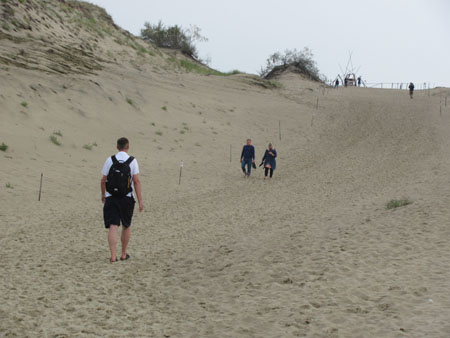 views
of the lagoon. After 20km the route cuts through the headland and we arrive
at the sea side. At a parking lot starts a hiking trail with explanatory
signs (called cognitive route) to the top of the highest dune, Parnidis, of
over 53 meters (174 ft). A footpath, partly reinforced with boards leads us
to a viewpoint where we can see both coasts.
views
of the lagoon. After 20km the route cuts through the headland and we arrive
at the sea side. At a parking lot starts a hiking trail with explanatory
signs (called cognitive route) to the top of the highest dune, Parnidis, of
over 53 meters (174 ft). A footpath, partly reinforced with boards leads us
to a viewpoint where we can see both coasts.
We cycle back towards Nida. Along the excellent paved bike path we come
across many like minded people on rental bikes, but also locals who are
looking for mushrooms. Apparently this is also a popular pastime in
Lithuania. Just before Nida we stop at a tavern, where we have lunch on the
waterfront in the sun.
In the afternoon we have a beer on our balcony. In the evening we eat at a
restaurant in the center of Nida. Simple but tasty. At 7pm hours a large
group of Lithuanians gathers in the dining room in front of the TV, because
the national basketball team plays against France for third place at the
2014 World Cup in Spain. Basketball is a great sport in Lithuania. The
country always ends in the top four at World Championships and Olympic
Games. Tonight the Green-Yellow brigade must bow their heads for
France and loose 95-93.
Our sleep is put to the test by the festivities in the pavilion at the
marina, opposite our B & B. The live music reverberates until 3am across the
harbor towards our facade. Earplugs offer some relief, fortunately.
Weather: overcast morning, then overcast with a lot of sun. 22°C/72°F.
Sunday 14 September 2014
Nida - Klaipėda
- Šiauliai: 221km, 137 mi; 3:30 hrs
Yesterday we got a cheese omelet at breakfast, this time an apple filled
pancake. We pack the remaining pancakes as a snack on the go. We take the
road to Klaipeda. It's cloudy, but gradually it clears up. We arrive
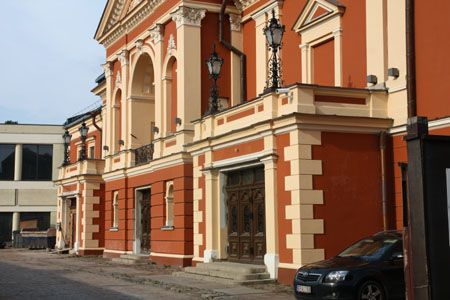 around
9 am at the ferry to the mainland. We drive to downtown Klaipėda and take a
coffee at the bar of the hotel next to the National Theatre. After coffee we
walk to the theater square. From the balcony of the theater Hitler addressed
the German population of Memel (as the city was then called) in 1939 on the
occasion of the Retun into the Empire of this predominantly
German-speaking city, having been annexed by the newly
independent Republic of Lithuania after the 1st World War. At the time
French troops watched the other way. In 1939 Memel was asssigned to Nazi
Germany due to the non-aggression pact with the Soviet Union. Hitler had
arrived in Memel with his armored cruiser Deutschland. The German
speaking Memelites were so excited about the new order that the
traditionally good relations with the Lithuanian speaking population became
completely disrupted. After the retreat of the German army in 1945 almost
all Germans fled the city. Now just a handful of German speakers still
lives in the
around
9 am at the ferry to the mainland. We drive to downtown Klaipėda and take a
coffee at the bar of the hotel next to the National Theatre. After coffee we
walk to the theater square. From the balcony of the theater Hitler addressed
the German population of Memel (as the city was then called) in 1939 on the
occasion of the Retun into the Empire of this predominantly
German-speaking city, having been annexed by the newly
independent Republic of Lithuania after the 1st World War. At the time
French troops watched the other way. In 1939 Memel was asssigned to Nazi
Germany due to the non-aggression pact with the Soviet Union. Hitler had
arrived in Memel with his armored cruiser Deutschland. The German
speaking Memelites were so excited about the new order that the
traditionally good relations with the Lithuanian speaking population became
completely disrupted. After the retreat of the German army in 1945 almost
all Germans fled the city. Now just a handful of German speakers still
lives in the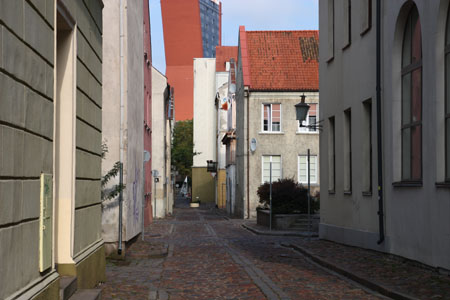 city. The theater is currently undergoing renovations. In the square stands
the Anna Fountain, dedicated to the girl from the popular German folk tune
"Änchen von Tharau". The composer came from Memel. We continue to Turgaus
Gatve along nicely restored 18th and 19th century buildings. We turn left on
Tiltu Gatve and then over the bridge. The bridge needs to be replaced. At
the moment there is a speed limit for the city bus. We walk through past the
grim music centre from the Soviet era and turn right into the Danes gatvė
towards the German post office in 1893. A neo-gothic building that still
serves as a post office. In 1914 a telephone operator remained at her post
and gave a running report directly to the German general staff of the
Russian advance into the city, when the rest of the population had taken to
boats and temporary refuge on the Curonian Spit. She was later awarded an
Iron Cross. We walk along the banks of the canal to the Castle Harbour. The
castle was a defense against the Teutonic Knights, who controled Estonia and
Latvia, until those countries were occupied by Sweden and later
by Russia. It is partly renovated and is part of the
city. The theater is currently undergoing renovations. In the square stands
the Anna Fountain, dedicated to the girl from the popular German folk tune
"Änchen von Tharau". The composer came from Memel. We continue to Turgaus
Gatve along nicely restored 18th and 19th century buildings. We turn left on
Tiltu Gatve and then over the bridge. The bridge needs to be replaced. At
the moment there is a speed limit for the city bus. We walk through past the
grim music centre from the Soviet era and turn right into the Danes gatvė
towards the German post office in 1893. A neo-gothic building that still
serves as a post office. In 1914 a telephone operator remained at her post
and gave a running report directly to the German general staff of the
Russian advance into the city, when the rest of the population had taken to
boats and temporary refuge on the Curonian Spit. She was later awarded an
Iron Cross. We walk along the banks of the canal to the Castle Harbour. The
castle was a defense against the Teutonic Knights, who controled Estonia and
Latvia, until those countries were occupied by Sweden and later
by Russia. It is partly renovated and is part of the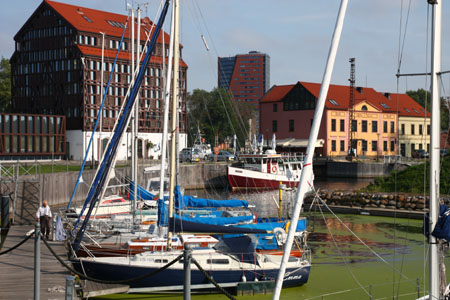 oldest part of the port of Klaipeda. The quays are being renovated and there
is now a promenade with cafes and restaurants. In order to get into the area
we have to cross a swing bridge. It is manually operated by a couple of
kids. In the harbor is an old shipyard from where you have a view of the
current port, which lies more towards the Baltic Sea. This also where the
foot ferry to the Curonian spit departs.
oldest part of the port of Klaipeda. The quays are being renovated and there
is now a promenade with cafes and restaurants. In order to get into the area
we have to cross a swing bridge. It is manually operated by a couple of
kids. In the harbor is an old shipyard from where you have a view of the
current port, which lies more towards the Baltic Sea. This also where the
foot ferry to the Curonian spit departs.
We take the car on the road again. This time to Šiauliai. This is another
two hours away. We drive on the A1 motorway and then continue on the A12
dual carriageway. As we enter the provincial town we are saddened by the
view of neglected Soviet Flats in very poor suburbs, which are only cheered
up a bit by an Akropolis shopping mall. Closer to the center, the
buildings get less monotonous, but not really nice. The In the town we turn
right twice to our hotel. Our heart misses a beat 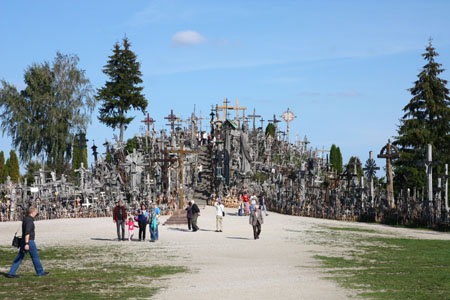 at
the sight of the street where our hotel should be. Terrible flats
(Platenbau), which have not been maintained since the 70s, it would seem.
There are a lot of relatively new midsize cars on the street, but the image
is that of a ghetto. That is where we find our hotel Turnė. This also makes
the impression that time has stood still since 1972. The reception is
correct and our room small and oddly decorated (one two single beds with a
large armchair in between) in 1970s style. Everything in orange and purple.
The furniture is somewhat faded and outdated. The bathroom looks like
recently renovated.
at
the sight of the street where our hotel should be. Terrible flats
(Platenbau), which have not been maintained since the 70s, it would seem.
There are a lot of relatively new midsize cars on the street, but the image
is that of a ghetto. That is where we find our hotel Turnė. This also makes
the impression that time has stood still since 1972. The reception is
correct and our room small and oddly decorated (one two single beds with a
large armchair in between) in 1970s style. Everything in orange and purple.
The furniture is somewhat faded and outdated. The bathroom looks like
recently renovated.
We walk to the center. The architecture is Stalinist , but the shops are
well up to date. It's Sunday, but the streets are filled with walking
couples and families. We eat at Varpa on Vilniaus street.
After lunch we take the car to
Kryžų Kalnas,
or the Hill of Crosses. This attraction is located 12km north of the city.
It is a hill which in the pagan period played a role in ancestor worshiping,
but it was after th001.jpg) e
anti-Russian uprising in the 19th century that the locals started to plant
home made crucifixes in honor of the martyrs. This practice persisted in
spite of pressure from the authorities. The Soviets buldozered the hill in
the 1960s completely, but the crosses came back. In 1993 Pope John Paul II
came to visit Lithuania and donated a special cross at the foot of the hill.
A Franciscan monastery was completed in 2001 just north of the hill. The
hill is completely covered with crosses. All are different and most are
products of folk art and handicrafts. Visitors are full of respect for the
sanctity and devotion of the place. We also see a group of young people who,
accompanied by their village priest visit the hill to place their own cross.
e
anti-Russian uprising in the 19th century that the locals started to plant
home made crucifixes in honor of the martyrs. This practice persisted in
spite of pressure from the authorities. The Soviets buldozered the hill in
the 1960s completely, but the crosses came back. In 1993 Pope John Paul II
came to visit Lithuania and donated a special cross at the foot of the hill.
A Franciscan monastery was completed in 2001 just north of the hill. The
hill is completely covered with crosses. All are different and most are
products of folk art and handicrafts. Visitors are full of respect for the
sanctity and devotion of the place. We also see a group of young people who,
accompanied by their village priest visit the hill to place their own cross.
Back in Šiauliai we eat at
Arkos café in the main
shopping street Vilniaus. The food is pretty good and the service
professional. After dinner we head back to the hotel.
Weather: overcast in the morning. Clear skies and sunny with max. Temp 21°C
/ 70°F
maandag 15 september 2014
Šiauliai - Kaunas: 160km; 99 mi; 1:30 hrs
Breakfast at
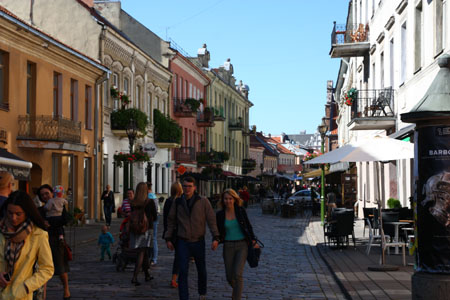 the
Turne Hotel is basic, but we can order eggs to your liking. They have
apparently run out of pancake flour, because we can not get any pancakes.
After breakfast we drive out of town towards Kaunas, where we arrive at half
past ten at
hotel Babilonas on a
hill just outside the center. We are kindly received and we can immediately
the spacious room. We walk from the hotel down the hill towards the city
center. On Vilnius Street in the old town we find a lively atmosphere
with many terraces and historic buildings. We eat at
Izy-bar.
After that we walk to the cathedral. Outside it is a austere Romanesque
church, but inside it is a baroque affair with many decorations and
paintings and a beautiful altar of Polish origin. The church was originally
from the early 15th century commissioned by Grand Duke Vytautas the Great.
We walk to the Town Hall Square, where we find the old town hall. It is now
primarily a wedding venue. It was originally a church, and that is reflected
in its shape. We walk on to the Episcopal Palace, the Trinity Church and the
the
Turne Hotel is basic, but we can order eggs to your liking. They have
apparently run out of pancake flour, because we can not get any pancakes.
After breakfast we drive out of town towards Kaunas, where we arrive at half
past ten at
hotel Babilonas on a
hill just outside the center. We are kindly received and we can immediately
the spacious room. We walk from the hotel down the hill towards the city
center. On Vilnius Street in the old town we find a lively atmosphere
with many terraces and historic buildings. We eat at
Izy-bar.
After that we walk to the cathedral. Outside it is a austere Romanesque
church, but inside it is a baroque affair with many decorations and
paintings and a beautiful altar of Polish origin. The church was originally
from the early 15th century commissioned by Grand Duke Vytautas the Great.
We walk to the Town Hall Square, where we find the old town hall. It is now
primarily a wedding venue. It was originally a church, and that is reflected
in its shape. We walk on to the Episcopal Palace, the Trinity Church and the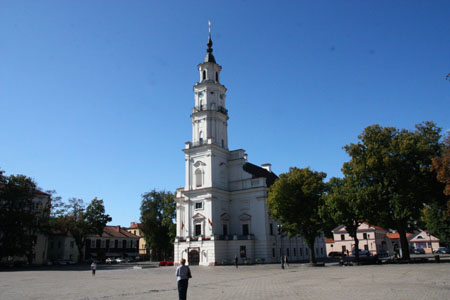 major seminary. A little further is St. George's Church and what is left of
the castle of Kaunas. This was a bulwark against the conquering drift of the
Teutonic Knights from Riga. We walk to the river Nemunas. Here is the
Vytautas Church from the 15th century, which was desacrated many times to
become an ammunition storage or a food storage and - like so many Lithuanian
churches - as Orthodox Church. Now it's a Catholic stronghold. Beside it is
the Perkuno Namas, once a club for the German speaking mercantile elite of
Kaunas.
major seminary. A little further is St. George's Church and what is left of
the castle of Kaunas. This was a bulwark against the conquering drift of the
Teutonic Knights from Riga. We walk to the river Nemunas. Here is the
Vytautas Church from the 15th century, which was desacrated many times to
become an ammunition storage or a food storage and - like so many Lithuanian
churches - as Orthodox Church. Now it's a Catholic stronghold. Beside it is
the Perkuno Namas, once a club for the German speaking mercantile elite of
Kaunas.
In the afternoon we go back into the city and have a cocktail at the Izy. We
follow this up with a very good meal at the cellar restaurant
Senieji Rusiai
(meaning "Old Cellars") just opposite . We dine in the Napoleon hall,
decorated with a mural depicting the Nemunas being crossed by Napoléon.
Lovely food and excellent service. We return to the hotel with the
trolley bus.
Weather: sunny but cold morning: 8°C/46°F.
Getting warmer in the afternoon: 18°C/46°F.
Tuesday 16 September 2014
Breakfast at Babilonas offers fairly broad range of options: cold meats,
cheeses, cereals. No fresh orange. There are only four tables
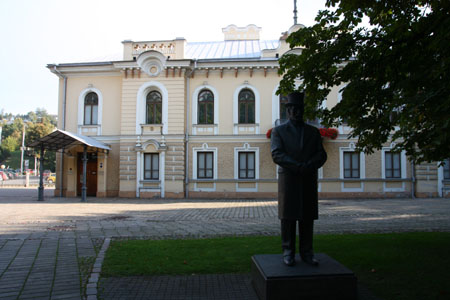 available.
We take the trolley bus to downtown. A single ticket costs only 2.50 litas
(€ 0.73). We drink coffee at a café called Vilnius and then walk to the
former temporary presidential palace. Between 1920 and 1939, when Lithuania
was independent, Vilnius belonged to Poland and Kaunas was the capital, as a
second choice. The palace is now a museum. In the garden are statues of the
four presidents who were head of state during that period. In the
garden we see a (temporary) photo exhibition on the events of 1915 when the
the German army drove the Russian army out of here during the First World
War.
available.
We take the trolley bus to downtown. A single ticket costs only 2.50 litas
(€ 0.73). We drink coffee at a café called Vilnius and then walk to the
former temporary presidential palace. Between 1920 and 1939, when Lithuania
was independent, Vilnius belonged to Poland and Kaunas was the capital, as a
second choice. The palace is now a museum. In the garden are statues of the
four presidents who were head of state during that period. In the
garden we see a (temporary) photo exhibition on the events of 1915 when the
the German army drove the Russian army out of here during the First World
War.
We walk on, side stepping from the Laisves aleja into an alley and arrive at
the Gertrud church. This small church from the 15th century is completely
hidden between the residential buildings around it. Unfortunately we can not
get in. We walk over the pedestrian zone of the Laisves aleja and arrive at
the post office. It has an Art Deco facade and nice authentic interior. This
part of town was built in the short period
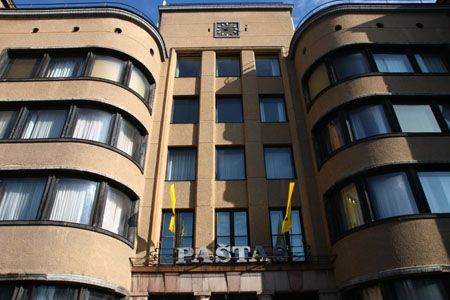 that
Kaunas was the capital and has a unity of style and planning. Kaunas will on
this basis of the modern center make a request to get it on the UNESCO list
of World Heritage Sites. Opposite the post office is the central park,
including a monument to a student who set fire on himself in 1972 as a
protest against the Soviet oppression. There followed days of riots, in
which 500 people were arrested.
that
Kaunas was the capital and has a unity of style and planning. Kaunas will on
this basis of the modern center make a request to get it on the UNESCO list
of World Heritage Sites. Opposite the post office is the central park,
including a monument to a student who set fire on himself in 1972 as a
protest against the Soviet oppression. There followed days of riots, in
which 500 people were arrested.
We walk to the Unity Square to Donelacio gatve. Here is a national monument
with eternal flame. On the edge of the square stands the
Great War museum. Besides many halls with guns, battles
swords, guns and models, there is also a room dedicated to Dariaus and
Gireno. These Lithuanians emigrated independently to the US and served in
the US Army during the First World War. After the war they became airmen.
Dariaus conceived the plan to fly non-stop from New York to Kaunas. He
invited Gireno to be his co-pilot. The money for the enterprise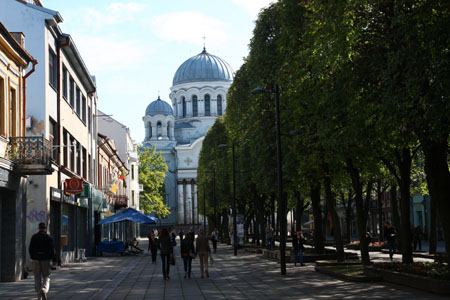 was raised from the Lithuanian community in the US. The men bought a second
hand plane that they named Lietuvica. They also took airmail with them, so
it was the longest non-stop flight but also the first transatlantic mail
flight. The adventure went wrong, as they crashed shortly before arrival in
East Prussian forest. They became heroes in their homeland. Their bodies
were embalmed in Kaunas and exhibited until the Soviets as to put an end to
that in 1944. After independence they received an honorable grave just
outside the city. The sports stadium in Kaunas is named after them and they
are on the banknote of 10 Litas. In the museum there is a lot parefenalia of
the flight, culminating in the complete wreck of the aircraft.
was raised from the Lithuanian community in the US. The men bought a second
hand plane that they named Lietuvica. They also took airmail with them, so
it was the longest non-stop flight but also the first transatlantic mail
flight. The adventure went wrong, as they crashed shortly before arrival in
East Prussian forest. They became heroes in their homeland. Their bodies
were embalmed in Kaunas and exhibited until the Soviets as to put an end to
that in 1944. After independence they received an honorable grave just
outside the city. The sports stadium in Kaunas is named after them and they
are on the banknote of 10 Litas. In the museum there is a lot parefenalia of
the flight, culminating in the complete wreck of the aircraft.
Next stop is the Church of the Archangel Michael at the end of the Laisves
Aleja. It is a colossal building with a large dome. It is now a Catholic
church, but has had several other functions and desecrations over time. The
church is quite full of worshipers during a mass. Opposite the church is the
Mykolo Žilinsko dailės Muziejus, the art collection of Mykolo Žilinsko
dailės. This museum was founded by a wealthy Lithuanian for his own art
collection. It is
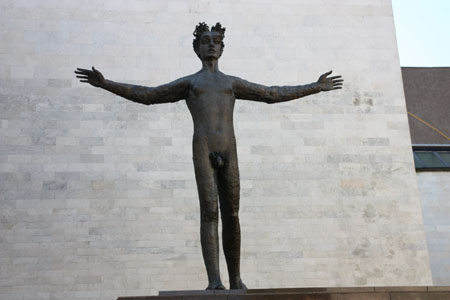 now
managed by the state art museum. It is housed in a modern building fronted
by an unabashedly big naked male figure, which has raised some eyebrows.
now
managed by the state art museum. It is housed in a modern building fronted
by an unabashedly big naked male figure, which has raised some eyebrows.
Later in the afternoon we go by car to the Pažaislis monastery. This is 7km
east of the center in a park on the edge of a lake. The monastery was
founded in the 17th century by a distinguished nobleman from the Grand Duchy
of Lithuania. During the Russian time it was closed, later an
American-Lithuanian order of nuns came to live here. The Soviets drove the
nuns out in 1944 road and made it a mental hospital, but since 1992 the nuns
are back. In one of the buildings there is now a conference center and
restaurant "Monte Pacis". The courtyard and the monastery church in the
monastery can be visited. It has a beautiful baroque interior. The exterior
is unfortunately somewhat neglected and could use a bit of paint.
We drive back to the hotel and around 5 pm we go into town for a cocktail at
Izy bar and dinner at the Town Hall Square at Medžiotojų užeiga,
a restaurant specializing in game. Good food and not too expensive.
Weather: sunny, but a cold start 9°C / 48°F.
Later it slowly warming up to 21°C / 70°F
Woensdag 17 september 2014
Kaunas - Vilnius: 101km, 63 mi; 1:20 hrs
After breakfast we
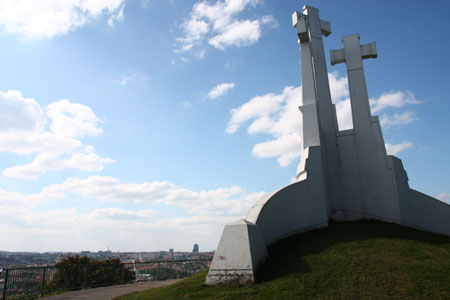 drive
into the center of Kaunas and drink coffee near the old presidential palace.
After coffee we drive to Vilnius, capital of Lithuania. It is not far away
and within 75 minutes we were there. We call Giedrius, the owner of the
apartment, which we booked through Airbnb.
He can be there in 40 minutes. He shows us the apartment and explains where
everything is in the city. We're right in the center, near the Town Hall
Square. Erik goes briefly to go shopping at a nearby Rimi supermarket. We
have lunch and later in the afternoon we take a taxi to the three cross
hill. We call a taxi company with a good reputation, Martono, because not
all taxi companies are equally reliable. From the hill we have a beautiful
panorama of the city. We walk down to the Cathedral, which we visit. The
building has been thoroughly renovated in the 19th century in a kind of
empire style. On the tympanum we see St Helena with a cross in her hand,
flanked by St C
drive
into the center of Kaunas and drink coffee near the old presidential palace.
After coffee we drive to Vilnius, capital of Lithuania. It is not far away
and within 75 minutes we were there. We call Giedrius, the owner of the
apartment, which we booked through Airbnb.
He can be there in 40 minutes. He shows us the apartment and explains where
everything is in the city. We're right in the center, near the Town Hall
Square. Erik goes briefly to go shopping at a nearby Rimi supermarket. We
have lunch and later in the afternoon we take a taxi to the three cross
hill. We call a taxi company with a good reputation, Martono, because not
all taxi companies are equally reliable. From the hill we have a beautiful
panorama of the city. We walk down to the Cathedral, which we visit. The
building has been thoroughly renovated in the 19th century in a kind of
empire style. On the tympanum we see St Helena with a cross in her hand,
flanked by St C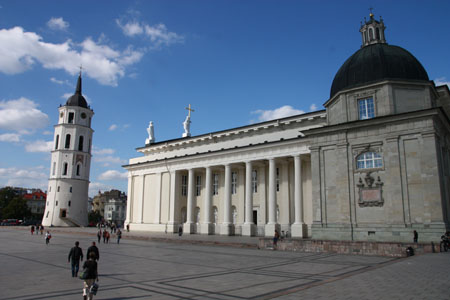 asimir
and St Stanislas, the patron saints of Lithuania Poland respectively.
Statues of Grand-Dukes of Lithuania and kings of Poland have been placed on
the outside of the building. They seem to have been caught in mid
gesture, which seems sort of comical. Inside, the Casimir chapel is the big
draw in rather austere interior. The chapel is richly decorated. It is a
gift of the first Polish king of the Wasa dynasty, originally a Swedish
family.
asimir
and St Stanislas, the patron saints of Lithuania Poland respectively.
Statues of Grand-Dukes of Lithuania and kings of Poland have been placed on
the outside of the building. They seem to have been caught in mid
gesture, which seems sort of comical. Inside, the Casimir chapel is the big
draw in rather austere interior. The chapel is richly decorated. It is a
gift of the first Polish king of the Wasa dynasty, originally a Swedish
family.
We walk back in the direction of the apartment and we have a drink at the
Town Hall. In the evening we have dinner at
Bistro 18 i in Stikliu
gatvė. A fine French restaurant with a short but nice menu. Fortunately, we
have reservations, because it is fully booked.
Weather: initially fog and cold (3°C / 37°F),
but later it was sunny and 21°C / 70°F
Thursday 18 September 2014
We have break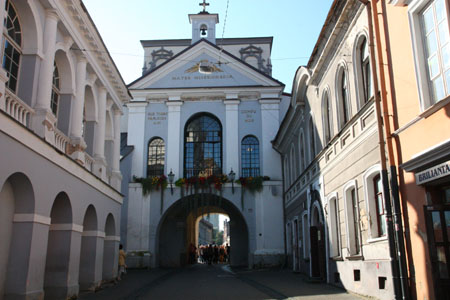 fast
in our apartment and then go out and drink coffee at Vero Café
on Town Hall Square. At 9:30 we meet our guide Agnieška
who will lead us through the city for 3 hours. We begin near the town
hall. First she tells us about the history of the city and the foundation by
Gedinimo in the 13th century. There are many churches in Vilnius Catholic,
Orthodox, Ukrainian Uniates and maybe more. We see the Basilian gate, which
gives access to the church of the Holy Trinity. This church belonged to a
monastery, but was desecrated by the Soviets and converted into a metal
factory. This building was seriously damaged. It is back in use as a church
of the Ukrainian Uniates, a Catholic community with many external
characteristics of the Orthodox Church (icons, the altar). We walk on and
pass the church of the Holy Spirit, an Orthodox church, attached to a
working Orthodox monastery. The design of the church is baroque and was
designed by a Catholic
fast
in our apartment and then go out and drink coffee at Vero Café
on Town Hall Square. At 9:30 we meet our guide Agnieška
who will lead us through the city for 3 hours. We begin near the town
hall. First she tells us about the history of the city and the foundation by
Gedinimo in the 13th century. There are many churches in Vilnius Catholic,
Orthodox, Ukrainian Uniates and maybe more. We see the Basilian gate, which
gives access to the church of the Holy Trinity. This church belonged to a
monastery, but was desecrated by the Soviets and converted into a metal
factory. This building was seriously damaged. It is back in use as a church
of the Ukrainian Uniates, a Catholic community with many external
characteristics of the Orthodox Church (icons, the altar). We walk on and
pass the church of the Holy Spirit, an Orthodox church, attached to a
working Orthodox monastery. The design of the church is baroque and was
designed by a Catholic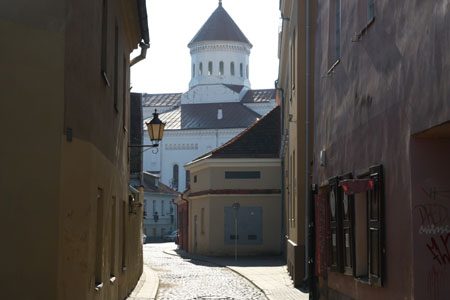 archtitect. In its form, a basilica, it also looks a lot like a Catholic
church. While we enter there is a mass in progress.
archtitect. In its form, a basilica, it also looks a lot like a Catholic
church. While we enter there is a mass in progress.
We continue to the gate of dawn. It is the eastern gate. There has been a
painting with the Virgin on it attached to the gate . This painting
miraculously withstood all kinds of disasters and fires and is highly
worshiped. It is now in a sort of decorated chapel in the gate, in
honor of that painting. An open-air mass was celebrated here in the
street in front of the gate during the visit of Pope John Paul in 1993. We
turn around and walk down Pilies gatve. We turn then right into Bernardinu
street, a narrow street with small works of art on the wall dedicated to
famous Vilnius residents, a kind of Wall of Fame.
One of the most famous sons of Vilnius is Czeslaw Milosz (1911-2004) is also commemorated here. He was the Nobel Prize winner for literature in 1980. This Lithuanian born poet of Polish origin, born near Kaunas, studied at the University of Vilnius. In 1951, he defected while being Polish cultural attaché in Washington to the West and started as a poet, writer and lecturer of Slavic languages in the US. Our guide Agnieska, also has a Polish background and speaks Polish at home. Vilnius has more minorities besides Lithuanians and Poles like Belarusians and Russians.
This char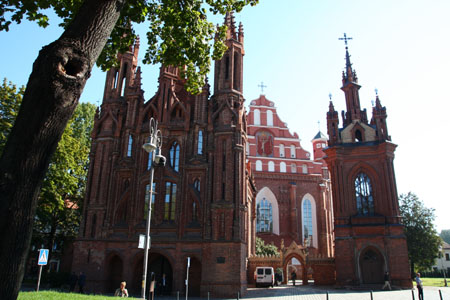 acteristic
street leads us to two churches in Gothic style: St Anne's Church and
Bernadine Church. St Anne's Church is very sophisticated with narrow turrets
with ornaments. Napoleon was so impressed by the church during his campaign
to Moscow in 1812 that he - in his own words - he would like to take it back
to Pariin the palm of his hand. In reality, the church was downgraded by his
troops to stable and the church was badly vandalized. The Bernardine Church
is much more austere. KGB founder Felix Dzerzinsky had a printing workshop
hidden in the basement to print communist pamphlets in the belief that the
Tsarist police would never look for it here. We cross the fast-flowing, but
shallow Vilnia river and arrive in the district of Užupis, a so called free
state for bohemians and artists. Literally Užupis means "across the river".
It was once one of the most unsavory neighborhoods of the city. When Vilnius
got an art school the penniless art students, attracted by the low rents,
settled here and this was how the district got its bohemian character. In
1997, the district declared itself "independent", similar to Christiania in
Copenhagen. These days it has become a sought after residen
acteristic
street leads us to two churches in Gothic style: St Anne's Church and
Bernadine Church. St Anne's Church is very sophisticated with narrow turrets
with ornaments. Napoleon was so impressed by the church during his campaign
to Moscow in 1812 that he - in his own words - he would like to take it back
to Pariin the palm of his hand. In reality, the church was downgraded by his
troops to stable and the church was badly vandalized. The Bernardine Church
is much more austere. KGB founder Felix Dzerzinsky had a printing workshop
hidden in the basement to print communist pamphlets in the belief that the
Tsarist police would never look for it here. We cross the fast-flowing, but
shallow Vilnia river and arrive in the district of Užupis, a so called free
state for bohemians and artists. Literally Užupis means "across the river".
It was once one of the most unsavory neighborhoods of the city. When Vilnius
got an art school the penniless art students, attracted by the low rents,
settled here and this was how the district got its bohemian character. In
1997, the district declared itself "independent", similar to Christiania in
Copenhagen. These days it has become a sought after residen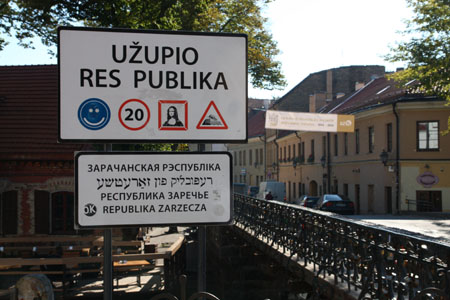 tial
area and even the mayor lives here. A famous son of the district is Felix
Dzerzinsky, a communist agitator during the tsarist time, who later became a
major supporter of Lenin during the revolution. He was given the task to set
up the Cheka, the secret police, which later became the FSB and KGB. His
former home is conspicuously without a memorial plaque. We drink coffee in
Uzupio Kavine which has become the social center of the neighborhood on the
river bank.
tial
area and even the mayor lives here. A famous son of the district is Felix
Dzerzinsky, a communist agitator during the tsarist time, who later became a
major supporter of Lenin during the revolution. He was given the task to set
up the Cheka, the secret police, which later became the FSB and KGB. His
former home is conspicuously without a memorial plaque. We drink coffee in
Uzupio Kavine which has become the social center of the neighborhood on the
river bank.
We walk through the neighborhood, along the "constitution", which is nailed
to the wall in Paupio street in 15 languages. It consists of 39 articles and
has three mottos: "Do not fight," "do not win" and "do not surrender". It
contains some very peculiar - if not frivolous - articles. Article 1 gives
people the right to live on the river Vilnele and the river the right to
flow right past the people. The national holiday of Užupis being April 1 is
a dead giveaway.
After this episode we walk into the old town to the presidential palace. It
was built for the Tsarist governor of Lithuania, by an architect who did not
know the location. The design, therefore, was too large for the intended
plot and a street had to be re-route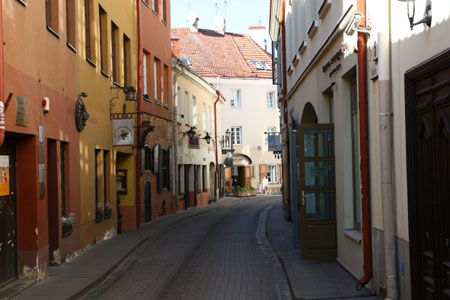 d
in order to get the whole thing to fit. Next to the palace is the oldest
university building. The university was founded in 1569 and has long been an
important center of (Polish language) science. Later Nobel laureate Czeslaw
Milosz (literature) studied here and took part in the Vagabond Club, a
movement of opposition students against the Russian Tsarist regime. After
the war, the University was "Lithuanianised" and currently has 14,000
students. Next we come through the Jewish quarter. Vilnius had until 1941 a
huge Jewish community. It was the largest religious group in the city with
approximately 200,000 members. The Nazis wasted no time after their invasion
in 1941 to herd the Jews into two designated ghettos. The first ghetto was
evacuated in 1941. The residents were killed in the forest of Paneriai. The
second ghetto was eliminated in July 1943. In the meantime, the ghetto
residents tried to maintain a community as much as they were able to. There
was even a resistance movement, but it all had little effect. In Kaunas,
where we were previously, the Lithuanians - even to the surprise of the
Germans - enthusiastically joined in the Holocaust. Also to participate in
Vilnius Lithuanians did the dirty work, these so-called wittebanders were
extremely anti-Semitic. Some Jews managed to escape throuhg the sewers with
help of the Jewish FPO resistance movement, but most disappeared to labor
camps, extermination camps or were shot in the woods. There is remarkably
little in the Jewish Quarter which reminds of the ghetto. On the site where
the great synagogue once stood, we now see a kindergarten. Not even a plaque
commemorates the historical significance of this place and the destruction
of the community in 1941. There is a monument for Elijah ben Solomon
(1720-92) who was an important Talmudic scholar who worked here. The
neighbourhod is crammed with ugly Soviet style apartment blocks. After
completion of the walk with Agnieska we have lunch in our apartment.
d
in order to get the whole thing to fit. Next to the palace is the oldest
university building. The university was founded in 1569 and has long been an
important center of (Polish language) science. Later Nobel laureate Czeslaw
Milosz (literature) studied here and took part in the Vagabond Club, a
movement of opposition students against the Russian Tsarist regime. After
the war, the University was "Lithuanianised" and currently has 14,000
students. Next we come through the Jewish quarter. Vilnius had until 1941 a
huge Jewish community. It was the largest religious group in the city with
approximately 200,000 members. The Nazis wasted no time after their invasion
in 1941 to herd the Jews into two designated ghettos. The first ghetto was
evacuated in 1941. The residents were killed in the forest of Paneriai. The
second ghetto was eliminated in July 1943. In the meantime, the ghetto
residents tried to maintain a community as much as they were able to. There
was even a resistance movement, but it all had little effect. In Kaunas,
where we were previously, the Lithuanians - even to the surprise of the
Germans - enthusiastically joined in the Holocaust. Also to participate in
Vilnius Lithuanians did the dirty work, these so-called wittebanders were
extremely anti-Semitic. Some Jews managed to escape throuhg the sewers with
help of the Jewish FPO resistance movement, but most disappeared to labor
camps, extermination camps or were shot in the woods. There is remarkably
little in the Jewish Quarter which reminds of the ghetto. On the site where
the great synagogue once stood, we now see a kindergarten. Not even a plaque
commemorates the historical significance of this place and the destruction
of the community in 1941. There is a monument for Elijah ben Solomon
(1720-92) who was an important Talmudic scholar who worked here. The
neighbourhod is crammed with ugly Soviet style apartment blocks. After
completion of the walk with Agnieska we have lunch in our apartment.
In the afternoon we go to the Jewish Museum. We walk through the Vilniaus
Gatve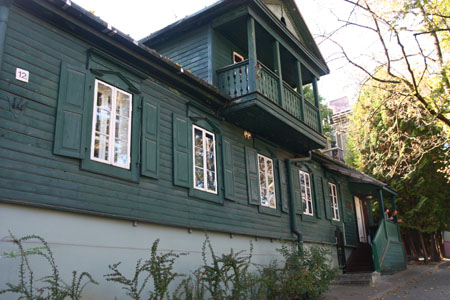 and come along the St Catherine's Church, a beautiful baroque church, which
now serves as a concert hall. The Jewish museum is unfortunately closed.
However, we can visit the Green House, the Holocaust Museum. Here is a small
but poignant exhibition about the systematic extermination of the Jews in
Lithuania. Chilling is the precision with which the Einsatzkommandos
performed their task and recorded it. Surprising are the stories of the very
few who by luck, courage or cunning plans have managed to survive genocide .
In the building is a replica of a family shelter. One of the members kept a
diary. This diary was found after the war and on the basis of this diary a
video has been made, which is shown in the reconstructed hide out. Hide out
survived the clearing of the ghetto in 1943, but after that it went wrong.
The hiding place was betrayed. The diarist was shot. His family escaped and
joined the partisans. After the liberation they came to the house and
found the diary.
and come along the St Catherine's Church, a beautiful baroque church, which
now serves as a concert hall. The Jewish museum is unfortunately closed.
However, we can visit the Green House, the Holocaust Museum. Here is a small
but poignant exhibition about the systematic extermination of the Jews in
Lithuania. Chilling is the precision with which the Einsatzkommandos
performed their task and recorded it. Surprising are the stories of the very
few who by luck, courage or cunning plans have managed to survive genocide .
In the building is a replica of a family shelter. One of the members kept a
diary. This diary was found after the war and on the basis of this diary a
video has been made, which is shown in the reconstructed hide out. Hide out
survived the clearing of the ghetto in 1943, but after that it went wrong.
The hiding place was betrayed. The diarist was shot. His family escaped and
joined the partisans. After the liberation they came to the house and
found the diary.
We walk from the Green House to Gedimino propektas, the main shopping street
with all the beautiful fashion stores. We have a drink on the terrace at La
Crepe. Nice location but lousy and unfriendly service.
In the evening we eat at
Lokys
(Bear), a restaurant specializing in game. I eat venison with mushrooms,
Erik stew of beef and venison.
After dinner we take a nightcap at Cafe
Montmartre,
opposite our apartment.
Weather: cold start (10°C / 50°F), sunny later
and 18°C / 64°F
Friday 19 September 2014
We drive to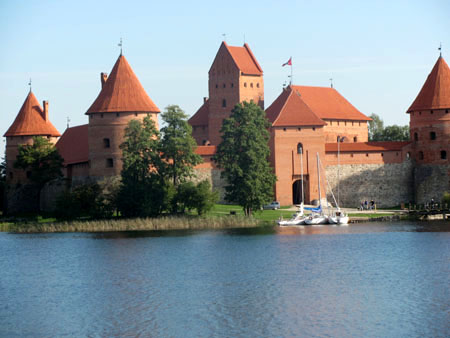 Trakai, about 24 km to the east. Here stands a castle, which is of great
importance to Lithuania and its national identity. We arrive 40 minutes
before opening time, so we drink some coffee at a local konditorei. As we
enter a school group barges in. They are here to do a chocolate workshop.
The castle dates from the 14th century, but was destroyed in the 17th
century. For a long time it was left as a ruin. It was built for Grand Duke
Vytautas the Great, the most important ruler of Lithuania in the 15th
century, when Lithuania was a great power in Eastern Europe and the empire
reached all the way to the Black Sea. In the 19th century, interest in the
glorious past picked up, and there were plans for preservation and
reconstruction of the castle. It took until 1962 when the Lithuanian Soviet
decided to rebuild it. Moscow looked the other way at this act of national
rehabilitation, but Khrushchev was reportedly furious when he heard about
it. The result is very nice. The castle, located on an island in a lake, is
beautifully situated. It occupies a strategic position and that was
important in the fight against the Teutonic
Trakai, about 24 km to the east. Here stands a castle, which is of great
importance to Lithuania and its national identity. We arrive 40 minutes
before opening time, so we drink some coffee at a local konditorei. As we
enter a school group barges in. They are here to do a chocolate workshop.
The castle dates from the 14th century, but was destroyed in the 17th
century. For a long time it was left as a ruin. It was built for Grand Duke
Vytautas the Great, the most important ruler of Lithuania in the 15th
century, when Lithuania was a great power in Eastern Europe and the empire
reached all the way to the Black Sea. In the 19th century, interest in the
glorious past picked up, and there were plans for preservation and
reconstruction of the castle. It took until 1962 when the Lithuanian Soviet
decided to rebuild it. Moscow looked the other way at this act of national
rehabilitation, but Khrushchev was reportedly furious when he heard about
it. The result is very nice. The castle, located on an island in a lake, is
beautifully situated. It occupies a strategic position and that was
important in the fight against the Teutonic
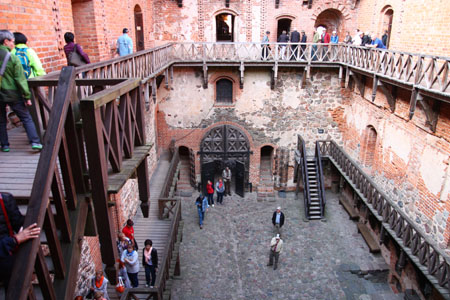 Knights,
who tried to conquer Lithuania and Latvia from Prussia. The castle is
in mint condition, as if it was built yesterday. There is a easy route
through the spaces in which a historical exhibition is set up about the
history of the castle, the country and the archaeological finds from the
surrounding area. It is crowded with tour groups, but it is just abut
doable. After the tour of the complex, which also includes a historical
museum we go back to Vilnius.
Knights,
who tried to conquer Lithuania and Latvia from Prussia. The castle is
in mint condition, as if it was built yesterday. There is a easy route
through the spaces in which a historical exhibition is set up about the
history of the castle, the country and the archaeological finds from the
surrounding area. It is crowded with tour groups, but it is just abut
doable. After the tour of the complex, which also includes a historical
museum we go back to Vilnius.
In Vilnius we have lunch in our apartment. In the afternoon we walk to the
university complex in the old town. It consists of a series of buildings
from the 16th to 19th century grouped around 9 courtyards. We look at them
all. In the courtyards we see professors in gowns holding mini lectures for
varying groups of students. It seems to be part of an induction program. It
looks very academically. The St John's Church is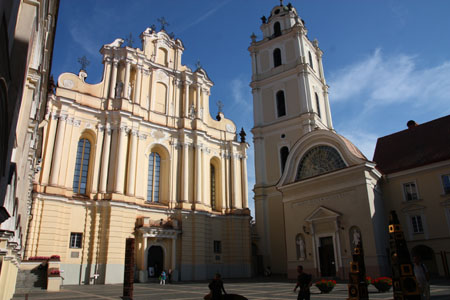 part of the complex. Baroque exterior, rococo and richly decorated inside.
The church was temporarily a warehouse during communism. The
university managed get back the church in the 1960s to use it as a
science museum. In 1991 the church was consecrated again. In one of the
chapels old science books are exhibited from the time it was a science
museum. The bell tower has an elevator and we cannot resist climbing it. The
view of the city is very beautiful. You do not see the whole city in
one panorama, but is a lot closer.
part of the complex. Baroque exterior, rococo and richly decorated inside.
The church was temporarily a warehouse during communism. The
university managed get back the church in the 1960s to use it as a
science museum. In 1991 the church was consecrated again. In one of the
chapels old science books are exhibited from the time it was a science
museum. The bell tower has an elevator and we cannot resist climbing it. The
view of the city is very beautiful. You do not see the whole city in
one panorama, but is a lot closer.
In the evening we have dinner at
La Bohème. It is a gran
thing in a former church building. Nice , but unfortunately there is a
wedding party in an adjoining room and they make an incredible noise. We are
happy when we are finished eating and we can go elsewhere for a coffee (Mama
Mia). Later we take a nightcap at Montmartre.
Weather: sunny. Fresh start with 10°C / 50°F,
but later 18°C / 64°F.

Saturday 20 September 2014
Vilnius - Vienna - Amsterdam - Rotterdam: 4:15 hrs flight
After breakfast we have coffee at Verocafé. Which only opens from 10am, so we just have to wait. It's raining slightly. We buy cheese at the Lithuanian cheese shop Dziugas on Vartu Ausros gatve, near our apartment as a souvenir. Then we take a cup of capucino in Montmartre, opposite from it. We are headed to the airport. At the airport, it is not so easy to find the drop-off place for the rental car. There are no signs to it. On a hunch we drive into the parking garage and we finally find the parking spaces for Europcar and other rental firms. Then we have to find the office. It appears to be in the arrivals hall, but where? There are two locations, but it is not clear who sits where. What a hassle. Then I have accompany the attendant to the car and back. The flight leaves on time at 13.45 and all goes well. The tight lay over (30 minutes) in Vienna, is more than sufficient. The planes are parked almost side by side. We are in Amsterdam just before 5pm. We take the Intercity Direct to Rotterdam and order Uber taxi home.
Weather: Vilnius cold and drizzle. In the Netherlands, sunny and 22
degrees
|
|
Other Travel | |
| back |